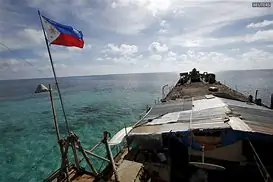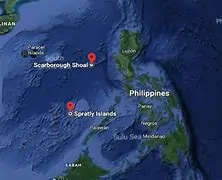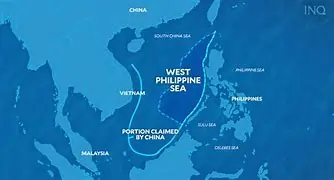
West Philippine Sea – Introduction:
The West Philippine Sea is a region of significant geopolitical importance, situated on the western side of the Philippines. It holds strategic value due to its rich marine resources, disputed territorial claims, and its role in regional security dynamics. This area, part of the South China Sea, is a focal point of contention between countries like the Philippines and China regarding sovereignty, maritime rights, and territorial boundaries.
Historically, the West Philippine Sea has been the center of disputes and conflicts. The Philippines asserts its claims over the waters and features based on international law and historical usage. Conflicting claims, particularly by China, have led to tensions and diplomatic negotiations.
Beyond a body of water, the West Philippine Sea is a critical maritime domain influencing trade routes, natural resource exploitation, and regional stability. It boasts marine biodiversity, including coral reefs and fish stocks, supporting local livelihoods and global marine conservation efforts.
Governed by international maritime laws like UNCLOS, the West Philippine Sea’s delineation of boundaries and recognition of sovereign rights are crucial for peace, security, and sustainable development. Recent incidents of incursions, illegal fishing, and military activities have raised concerns, prompting the Philippines to defend its sovereignty through diplomatic means, arbitration, and partnerships.
In essence, the West Philippine Sea is a complex mix of legal, political, environmental, and security considerations shaping the region’s future. Understanding its significance requires appreciation of its history, dynamics, and implications for regional stability. Dialogue, cooperation, and adherence to international law are essential for promoting peace and security in this contested maritime space.

The territorial claims in the West Philippine Sea have a long and complex historical context involving multiple countries asserting sovereignty over the region. Here is a brief overview of the historical background of the territorial claims in the West Philippine Sea:
- Historical Usage: The Philippines, China, Vietnam, Malaysia, Brunei, and Taiwan have historical ties to the West Philippine Sea region, with each claiming rights based on ancient maps, cultural connections, and historical activities like fishing and trade.
- Colonial Influence: The colonial history of the region, with countries like Spain, the United States, and France exerting control over certain territories, has influenced modern-day territorial disputes. The Treaty of Paris in 1898 transferred the Philippines from Spain to the United States, impacting territorial boundaries.
- Post-World War II Developments: The end of World War II saw changes in territorial control, with countries like China and Vietnam asserting claims over islands and maritime areas in the West Philippine Sea. The 1947 nine-dash line map by China became a focal point of their claim to vast maritime territories.
- United Nations Convention on the Law of the Sea (UNCLOS): The adoption of UNCLOS in 1982 established rules for maritime boundaries, exclusive economic zones (EEZs), and continental shelf rights. Countries in the region have used UNCLOS to support their claims and resolve disputes.
- Modern Disputes: Tensions escalated in the late 20th and early 21st centuries due to conflicting claims over islands, reefs, and waters in the West Philippine Sea. Incidents of maritime standoffs, military patrols, and resource exploitation have characterized the disputes.
- Arbitration and Diplomatic Efforts: The Philippines pursued legal action through an arbitration case against China in 2013, challenging the validity of China’s claims and activities in the West Philippine Sea. The arbitral tribunal ruled in favor of the Philippines in 2016, emphasizing the importance of international law in resolving disputes.
The historical context of territorial claims in the West Philippine Sea is shaped by colonial legacies, post-World War II developments, international law, and modern geopolitical dynamics. The region’s history reflects a complex interplay of sovereignty, maritime rights, and strategic interests among the claimant countries.
International laws and treaties have played a significant role in influencing the disputes in the West Philippine Sea region. Here are some key ways in which international laws and treaties have impacted the territorial and maritime disputes in the area:
- United Nations Convention on the Law of the Sea (UNCLOS): UNCLOS, adopted in 1982, establishes the legal framework for the use of the world’s oceans and seas. It defines maritime zones, rights and duties of states, and mechanisms for resolving disputes. UNCLOS has been instrumental in clarifying maritime boundaries, exclusive economic zones (EEZs), and continental shelf rights in the West Philippine Sea.
- Territorial Claims and Sovereignty: UNCLOS provides guidelines for determining maritime boundaries, including territorial waters, EEZs, and the continental shelf. Countries in the West Philippine Sea region have used UNCLOS to support their territorial claims, clarify their rights to resources, and resolve disputes over overlapping claims.
- Arbitration and Legal Mechanisms: Countries have utilized legal mechanisms, such as arbitration under UNCLOS, to resolve disputes in the West Philippine Sea. For example, the Philippines brought a case against China to the Permanent Court of Arbitration, challenging China’s claims and activities in the region. The tribunal’s ruling in 2016 affirmed the importance of international law in resolving maritime disputes.
- Freedom of Navigation and Overflight: UNCLOS upholds the principle of freedom of navigation and overflight in the world’s oceans, including the West Philippine Sea. Disputes over the interpretation and implementation of these rights have led to tensions among claimant countries and external powers operating in the region.
- Regional Agreements and Codes of Conduct: Countries in the region have also sought to address disputes through regional agreements and codes of conduct. Initiatives like the Declaration on the Conduct of Parties in the South China Sea (DOC) and efforts to negotiate a Code of Conduct (COC) aim to promote peaceful dialogue, confidence-building measures, and cooperative actions among claimant states.
In International laws and treaties, particularly UNCLOS, have shaped the legal framework for addressing territorial and maritime disputes in the West Philippine Sea. These instruments provide guidelines for resolving conflicts, clarifying rights, and promoting stability in the region through adherence to established norms and principles of international law.

Different countries’ interpretations of international laws, particularly regarding maritime rights and territorial claims, contribute significantly to ongoing tensions in the West Philippine Sea. Here are some ways in which divergent interpretations impact the disputes in the region:
- Sovereignty and Territorial Claims: Countries in the region have varying interpretations of historical rights, international law, and legal precedents regarding sovereignty over islands, reefs, and waters in the West Philippine Sea. Disagreements over the validity of claims based on historical maps, activities, and colonial legacies fuel territorial disputes and competing claims.
- Exclusive Economic Zones (EEZs) and Resources: Differences in interpreting UNCLOS provisions related to EEZs, continental shelf rights, and resource exploitation contribute to tensions over fishing grounds, oil and gas reserves, and other marine resources. Competing claims to maritime zones and overlapping EEZ boundaries result in disputes over access to and control of valuable resources.
- Freedom of Navigation and Military Activities: Conflicting interpretations of freedom of navigation and overflight rights under international law lead to maritime incidents, military patrols, and exercises that heighten tensions in the West Philippine Sea. Disputes over the legality of military activities, such as freedom of navigation operations, challenge the security and stability of the region.
- Arbitration and Legal Disputes: Varied understandings of the applicability and enforcement of international legal decisions, such as arbitral rulings, create obstacles to resolving disputes in the West Philippine Sea. Non-compliance with arbitration outcomes or differing views on the interpretation of legal obligations prolong conflicts and hinder diplomatic efforts to find peaceful solutions.
- Regional Cooperation and Codes of Conduct: Disparities in interpreting regional agreements and codes of conduct, such as the DOC and proposed COC, affect the implementation of confidence-building measures and cooperative actions among claimant states. Differing expectations and priorities among countries impede progress towards achieving a rules-based order and conflict resolution mechanisms.
In summary, divergent interpretations of international laws and agreements contribute to ongoing tensions in the West Philippine Sea by shaping competing narratives, interests, and approaches to resolving territorial and maritime disputes. Bridging these differences through dialogue, diplomacy, and adherence to established legal norms is essential for promoting stability and cooperation in the region.
The West Philippine Sea conflict has significant implications for regional stability in Southeast Asia and beyond. Here are some ways in which the conflict impacts regional stability:
- Security Concerns: Tensions in the West Philippine Sea raise security concerns among neighboring countries and major powers with interests in the region. Military activities, maritime standoffs, and the presence of naval forces contribute to a sense of insecurity and the risk of escalation.
- Economic Disruption: The West Philippine Sea is a vital maritime route for trade, with significant economic implications for regional countries. Disputes over maritime boundaries, fishing rights, and resource exploitation can disrupt economic activities, such as fishing, shipping, and energy exploration, affecting regional prosperity.
- Diplomatic Relations: The West Philippine Sea conflict strains diplomatic relations among claimant states and external powers involved in the disputes. Frictions over sovereignty, territorial claims, and compliance with international law create challenges for bilateral and multilateral diplomacy, hindering efforts to build trust and cooperation.
- Regional Alliances and Partnerships: The conflict influences the alignment of countries in the region, leading to the formation of strategic alliances and partnerships to address shared security concerns. Countries seek to strengthen defense cooperation, engage in joint exercises, and enhance maritime security capabilities to counterbalance perceived threats in the West Philippine Sea.
- Rule of Law and International Norms: Adherence to international law, particularly UNCLOS, is essential for upholding the rule-based order in the West Philippine Sea and beyond. Violations of legal norms, non-compliance with arbitral rulings, and unilateral actions that undermine the principles of peaceful dispute resolution challenge the stability of the region and erode trust among states.
- Environmental Impact: The West Philippine Sea conflict has environmental consequences, including damage to coral reefs, marine ecosystems, and biodiversity due to unsustainable fishing practices, pollution, and resource extraction activities. Environmental degradation in the region affects livelihoods, food security, and ecological sustainability, contributing to instability.
In conclusion, the West Philippine Sea conflict’s impact on regional stability underscores the interconnectedness of security, economic, diplomatic, and environmental factors in shaping the security landscape of Southeast Asia. Mitigating tensions, promoting dialogue, and upholding international norms are essential for fostering peace, cooperation, and stability in the region.
You may also read like:




